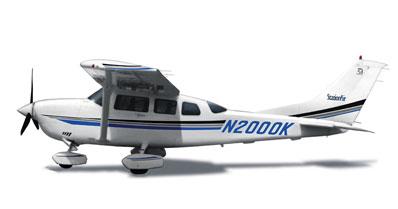Alaska Take-Off From Bad Runway Winds Up In The Drink
Sometimes, the great skill that a pilot can have is to know when
to quit and judging from the factors involved in this accident,
there seems to have been a number of issues to conntend that may
have benefitted from a change in plans. A short runway, potholes
and the reported downdraft made this takeoff a mess right from the
start.
File Photo

NTSB Identification: ANC12FA014
Scheduled 14 CFR Part 135: Air Taxi & Commuter
Accident occurred Thursday, December 15, 2011 in Nanwalek, AK
Aircraft: CESSNA U206G, registration: N252AL
Injuries: 4 Minor.
This is preliminary information, subject to change, and may contain
errors.
On December 15, 2011, about 1530 Alaska standard time, a Cessna
U206G airplane, N252AL, sustained substantial damage when it
impacted ocean waters shortly after takeoff from Runway 01 at the
Nanwalek Airport, Nanwalek, Alaska. The airplane was being operated
by Smokey Bay Air, Homer, Alaska, as a visual flight rules (VFR)
scheduled commuter flight under 14 Code of Federal Regulations Part
135. The pilot and three passengers sustained minor injuries.
Visual meteorological conditions prevailed at the time of the
accident, and company flight following procedures were in effect.
The flight originated from the Homer Airport about 1445, with a
stop in Port Graham, Alaska.
In a written statement to the Federal Aviation Administration
(FAA), the pilot stated that the wind at the airport was from the
east at 12 to 15 knots, and the runway was covered with
approximately 3 inches of slush, with as much as 6 inches in the
potholes. During the takeoff roll on runway 01, the
airplane’s acceleration was degraded due to the runway
contamination, but it became airborne near the midpoint of the
runway. He stated that as he was making a left turn, the airplane
encountered a strong down draft. With full power applied to the
engine and the airplane’s pitch attitude set to best angle of
climb, he said the airplane was still descending approximately 500
feet per minute. When he realized that the airplane was not going
to climb, he reduced the engine power to idle and ditched the
airplane approximately 100 feet from the shore. After the airplane
entered the water, the pilot and three passengers evacuated the
airplane through the pilot’s door and began to swim to shore,
where they were assisted by local bystanders.
Another pilot that was at the north end of the airport said he
saw the airplane takeoff in a nose high attitude, “as you
would expect of a soft-field takeoff.” He stated that the
airplane continued in a very nose high attitude until it descended
below his line of sight, at which time he went to his airplane and
radioed another pilot flying in the area, and informed him that an
airplane was down near Nanwalek.
The area surrounding the Nanwalek airport produces significant
turbulence and downdrafts, especially when the prevailing wind is
from the east. The airport is tightly constrained by terrain and
water on all sides, and the 1,850 feet runway is not regularly
maintained. The FAA Airport/Facility Directory, Alaska Supplement
listing for the Nanwalek Airport contains the following notation:
“Airport Remarks – Unattended. Runway 01-19 north 1,000
feet CLOSED indefinitely, remaining 850 feet soft.”
 ANN's Daily Aero-Term (05.19.25): Fuel Remaining
ANN's Daily Aero-Term (05.19.25): Fuel Remaining ANN's Daily Aero-Linx (05.19.25)
ANN's Daily Aero-Linx (05.19.25) Klyde Morris (05.16.25)
Klyde Morris (05.16.25) Airborne 05.19.25: Kolb v Tornados, Philippine Mars, Blackhawk Antler Theft
Airborne 05.19.25: Kolb v Tornados, Philippine Mars, Blackhawk Antler Theft Airborne-Flight Training 05.15.25: Ray Scholarship, Alto NG, Fighter Training
Airborne-Flight Training 05.15.25: Ray Scholarship, Alto NG, Fighter Training



